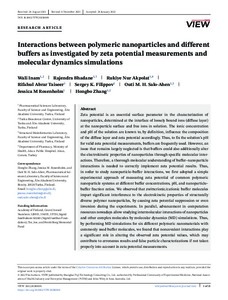Interactions between polymeric nanoparticles and different buffers as investigated by zeta potential measurements and molecular dynamics simulations
Inam Wali; Bhadane Rajendra; Akpolat Rukiye Nur; Taiseer Rifahul Abrar; Filippov Sergey K.; Salo-Ahen Outi M. H.; Rosenholm Jessica M; Zhang Hongbo
https://urn.fi/URN:NBN:fi-fe2022081154346
Tiivistelmä
Zeta potential is an essential surface parameter in the characterization of nanoparticles, determined at the interface of loosely bound ions (diffuse layer) at the nanoparticle surface and free ions in solution. The ionic concentration and pH of the solution are known to, by definition, influence the composition of the diffuse layer and zeta potential accordingly. Thus, to fix the solution's pH for valid zeta potential measurements, buffers are frequently used. However, an issue that remains largely neglected is that buffers could also additionally alter the electrokinetic properties of nanoparticles through specific molecular interactions. Therefore, a thorough molecular understanding of buffer-nanoparticle interactions is needed to correctly implement zeta potential results. Thus, in order to study nanoparticle-buffer interactions, we first adopted a simple experimental approach of measuring zeta potential of common polymeric nanoparticle systems at different buffer concentrations, pH, and nanoparticle-buffer fraction ratios. We observed that zwitterionic/cationic buffer molecules impart significant interference to the electrokinetic properties of structurally diverse polymer nanoparticles, by causing zeta potential suppression or even inversion during the experiments. In parallel, advancement in computation resources nowadays allow studying intermolecular interactions of nanoparticles and other complex molecules by molecular dynamics (MD) simulations. Thus, by performing MD simulations for six different polymeric nanomaterials with commonly used buffer molecules, we found that noncovalent interactions play a significant role in altering the observed zeta potential values, which may contribute to erroneous results and false particle characterizations if not taken properly into account in zeta potential measurements.
Kokoelmat
- Rinnakkaistallenteet [27094]
